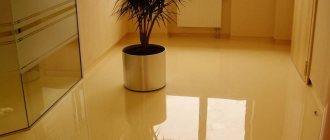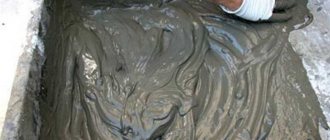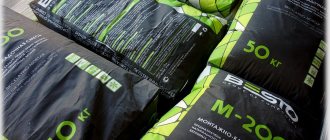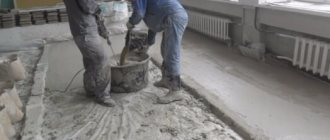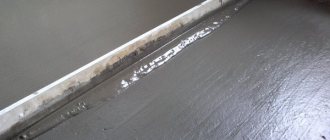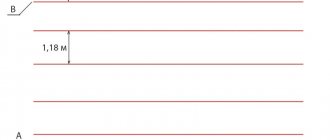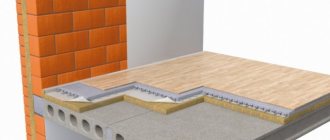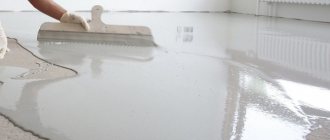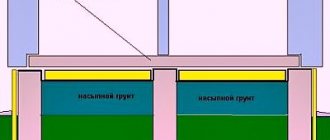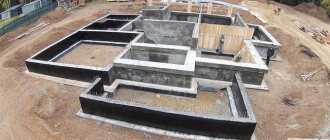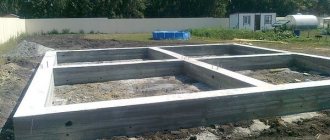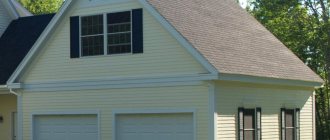Functions and thickness of the screed
Cement screed is used when leveling floors with differences of about 20 mm or with significant, deep damage to the floor. Options for screed construction differ in what materials are used for it (expanded clay, sand, cement, fiber, crushed stone, gravel) or manufacturing methods.
Functions of floor screed:
- leveling the surface under the floor covering;
- giving a certain slope to the floor;
- improvement of thermal insulation, sound insulation;
- concealment of communications and pipelines;
- creation of a “warm floor” system.
Important!
The water-cement ratio is one of the main characteristics that determines the qualitative properties of the mixture after hydration. The minimum indicator is 0.3 (30% of water is taken from the total amount of cement), but if you take less water, voids may form inside the screed. The maximum value is 0.7, with more water the mixture will be unreliable!
The minimum thickness of the screed, according to building codes, is 30 mm. Reducing it is highly not recommended, because this reduces the life of the floor and can lead to emergency situations. The thickness of the screed is always calculated individually. This takes into account:
- required thickness - in some cases the floor needs to be raised, in others it needs to be lowered;
- requirements for the future floor - the more reliable it must be, the thicker the layer is made;
- type of room;
- type of future floor covering;
- features of the components selected for the solution;
- is reinforcement used?
In different cases, builders recommend making a screed of one thickness or another. So for a height difference of 15 mm, a 30 mm layer above the highest point is sufficient. If a heated floor system is installed, then it is also necessary to use a minimum of 30 mm screed. On the balconies everything is different. They are not so reliable, so the screed is made in a layer of 4 cm.
The maximum permissible thickness of a simple screed is 12 cm. Such layers are rarely made and sand concrete is used for this. A screed about 20 cm thick is made with the addition of expanded clay for lightness.
Photo of floor screed
Why is the screed calculated?
A sand-cement mixture is called a screed. It is used to level the surface or to create a coating before starting finishing work. In addition, its functions include hiding communication nodes. Hydro- and thermal insulation is applied to the floor screed.
A positive feature of such a screed is its demand, since the composition is suitable for any finished floor. This construction option is considered affordable, because all the necessary components can be purchased at reasonable prices in a specialized store. The coating is quite durable and has a service life of several years.
In addition, such a composition is capable of insulating sound, which is important when building apartment buildings.
Main purposes:
- coating for technical purposes, which will remain final (garage floor);
- intermediate element for further installation work;
- in the form of a continuous coating (to level the surface);
- self-leveling solution (it is quite liquid, so a sealed base is required).
In the latter case, the surface does not need to be leveled, since the composition itself spreads over the treated area.
Floor screed materials
Also check out these articles
- Features of the use of metal fences made of corrugated sheets
- Features of using mortise locks
- Practicality of laser levels
- Single-phase rectifiers
Cement, sand, water - these are the materials that are purchased for floor screed.
- Sand of a certain type is used for different types of premises. For rooms with increased load on the floor, it is worth using fine-grained river sand. It allows you to make the most dense “blanket”. For simple premises, office, residential, you can purchase mountain sand, perhaps even with an admixture of clay, this will not hurt. The grain fraction is ideally up to 2 mm - this is very important for a high-quality screed.
- Cement is the main component of the screed. It is this that determines the strength and density of the future base for the coating. It comes in different brands. And depending on the brand of cement, the amount of other components in the solution may vary. So the calculation of cement for floor screed should be carried out using tables or using a floor screed consumption calculator.
Table of proportions for obtaining concrete:
| Cement brand | Proportions (cement/sand) | Brand of the resulting solution |
| 600 | 1:3 | 300 |
| 600 | 1:4 | 200 |
| 500 | 1:2 | 300 |
| 500 | 1:3 | 200 |
| 400 | 1:1 | 300 |
| 400 | 1:2 | 200 |
| 400 | 1:3 | 150 |
| 300 | 1:1 | 200 |
| 300 | 1:2 | 150 |
| 300 | 1:3 | 100 |
- The water is taken clean, without impurities of earth, clay, fat or organic waste. It should also not contain chemicals. If the water is dirty, the service life of the screed may be reduced. You can use simple tap water - it is quite suitable for these purposes.
In addition, if the screed is made more than 4 cm thick, then sometimes crushed stone is additionally used. To make the screed less heavy, fillers such as expanded clay, vermiculite and perlite are used.
Depending on the type of components, one or another brand of concrete is obtained after mixing all the components. Below is a table of the ratios necessary to obtain a particular quality of concrete, in the case when crushed stone is also used.
Table of proportions for producing concrete with crushed stone:
| Concrete grade | Cement/sand/crushed stone ratio | |
| Cement M400 | Cement M500 | |
| 100 | 1,0:4,0:6,0 | 1,0:5,2:7,0 |
| 150 | 1,0:3,1:5,0 | 1,0:4,0:5,8 |
| 200 | 1,0:2,4:4,1 | 1,0:3,1:4,8 |
| 250 | 1,0:1,8:3,3 | 1,0:2,4:3,9 |
| 300 | 1,0:1,6:3,2 | 1,0:2,1:3,6 |
| 400 | 1,0:1,1:2,5 | 1,0:1,4:2,7 |
| 450 | 1,0:1,0:2,1 | 1,0:1,2:2,4 |
We calculate the solution and screed consumption
Construction work on pouring the floor must be carried out continuously. The prepared mixture cannot stand for long, because it loses its properties. Under such conditions, it is necessary to calculate the consumption of materials.
Factors influencing the volume of components required:
- area of the room being treated;
- the initial quality of the coating (the thickness of the layer depends on this);
- product brand;
- sand quality.
Before calculating the amount of cement, the following features should be analyzed:
- the presence of plastic components in the composition;
- sulfate resistance;
- percentage of additives;
- the level of load that this coating must withstand.
Many beginning builders do not know how much material they need to purchase. There is no standard formula, so everyone uses their own calculation system.
After setting the zero level and calculating the required thickness, the area of the room is determined (for example, 10 m²).
The resulting figure should be multiplied by the height of the screed (50 mm). As a result, 0.5 m³ of cement is needed to fill the specified area.
You can calculate the volume of the mixture in kilograms as follows:
- The mixture consumption per 1 m2 of screed with a thickness of 5 cm is about 20 kg/m2.
- When this figure is multiplied by 0.5 m³, the result is 1000 kg.
- When dividing the result by the weight of 1 bag (50 kg), you get 20 pieces.
A layer 10 cm thick will require 50 kg of cement for an area of 1 m². During the work, the material even gets into small cracks, so when calculating the amount of cement for a floor screed, it is recommended to take the material in excess (25-30%). When kneading, dry substances decrease in volume due to their combination with water, so the final volume will be much lower.
To obtain a high-quality screed, it is recommended to adhere to the rules for making the solution. If the technology is violated, the composition will be heterogeneous and cracks may appear.
Recommendations for preparing the solution:
- First, the bulk dry ingredients are mixed. It is recommended to maintain proportions to the nearest kilogram. Otherwise, the batch will turn out to be of poor quality.
- Any plasticizers and liquid additives are initially combined with water. How much cement you should use depends on the brand. The instructions indicate the exact proportions. You should not save on material and take less quantity, as this will negatively affect the quality of the coating. On average, 1 bag of cement for floor screed (weighing 50 kg) will require 200 kg of plasticizer.
- When mixing a dry substance with a liquid, the latter is gradually poured into the container with the powder, and not vice versa. It is recommended to constantly stir the mixture and avoid the formation of lumps.
To make the process easier, it is recommended to use the following tools:
- mixer;
- drill.
In this case, the mixing process will take much time.
What and why to reinforce the screed?
The quality characteristics of the screed can be increased through reinforcement. To do this, you can use a metal mesh or fiberglass.
- Reinforcing metal mesh is used more often than fiberglass. Welded mesh made of 4-5 mm rods, which is produced in rolls or sections, is suitable. The second option is reinforcement bars with a cross-section of up to 12 mm, fastened with wire. This will provide additional strength, but reinforcement bars will be more expensive than solid mesh. The mesh is usually laid with an overlap, so it is taken 20-30% larger than the total area of the room.
Important!
Reinforcement with mesh or rods significantly increases the weight of the screed. And the minimum layer of screed increases to 30 mm, and this is not always possible.
- Fiber fiber for screeding began to be used not as long ago as metal mesh, but it is already quite popular. This material consists of thin polypropylene fibers 3-18 mm long. It is added immediately to the solution (before adding water) in the required quantity. It is easy to use, resistant to mechanical damage, waterproof, not very expensive and not heavy like reinforcing mesh. Fiber consumption – 0.6-0.9 kg/m. cube of solution.
Photo of reinforcing mesh for the floor
Proportions of a classic DSP screed
The classic mortar for floor screed, as already mentioned, is cement with sand diluted with water. The proportion (the amount of sand per unit of cement) depends on the required strength of the screed and the brand of cement used. To make the floor surface durable, use expensive Portland cement grade M400 and higher.
Proportions of mortar for floor screed for M150, M200 and M300 when using different grades of cement
For screeding floors in utility rooms, you can also use the cheaper M300. It will cost a little more, but there will be savings. It is better not to use such cement for the foundation of a house or apartment under modern coatings. The rework will require significantly more savings on cement.
Beginners in the construction business think that if you take more cement, there will be a stronger screed. But no. For strength, the correct ratio of all components is important, and an excessive amount of cement can cause a decrease in strength. If you want a stronger screed, use high-quality cement and accurately measure the proportions. By the way, you shouldn’t take more water either. This will increase the fluidity of the solution, but will increase the number of shrinkage cracks. So once again: in order to get strong and reliable concrete, you need to strictly observe the proportions.
Which sand to take
It is better to take river sand, washed, of at least two fractions: coarse and medium. Why river? Because it has sharp edges, and this reduces the likelihood that it will settle into the lower layers. This is understandable. Why washed? It contains minimal dust. The less dust, the higher the strength of the solution. Sand is also needed in different sizes so that the strength of the solution is normal.
To screed the floor you need sand: washed river sand, two fractions (not fine)
If you are going to lay an expensive coating on the floor with high requirements for the strength of the base (parquet, parquet or engineered boards, vinyl tiles), it is better to take this kind of sand. There will be fewer problems.
Kneading sequence
When making a floor screed solution, first mix the dry ingredients - cement and sand. When mixing manually (in a trough), there is not much difference between what to throw in first - cement or sand. If you use a concrete mixer, immediately add sand and spin it for a couple of minutes without cement. Then, gradually, usually with shovels, cement is added. After each portion, wait until it is more or less evenly distributed, then add the next one. After adding the entire amount of binder, mix until a uniformly colored mixture is obtained.
You choose how to prepare the solution yourself: order it at the factory/workshop, mix it yourself
When the dry ingredients are mixed until a homogeneous gray mass is obtained, add water little by little. It is calculated based on the amount of cement. Usually 0.45-0.55 parts of water are taken for 1 part of cement. Why don't they indicate exactly? Because the amount of water depends on the moisture content of the sand. It is advisable to pour a minimum amount of water: this way there will be fewer cracks when drying.
Ready-made mortar or sand-cement mixture
Those who have at least once mixed DSP or concrete on their own are more often inclined to buy ready-made concrete. And not a mixture of sand and cement in bags, but concrete from a concrete mixer. Yes, it costs more money, but it requires much less time and effort. Another advantage of this solution: filling without cold seams. This means fewer cracks and problems in the future. The next plus is that concrete mixers can deliver the solution to the desired floor. Imagine that you have to move a couple of tons of sand and cement. Even if there is a freight elevator, it is not easy. It can also be costly if you pay helpers. Climbing stairs “on your shoulders” is generally a problem.
So that you do not care about the proportions of cement and sand, you can buy ready-made mixture in bags
What are the advantages of buying ready-made sand-cement mixture in bags? The fact is that the proportion is kept exactly, sand is used in several fractions and in the right quantities. That is, the screed is guaranteed to have the required strength. The downside is the price. You can buy the same amount of cement and sand for a much smaller amount. This is if you don’t bother with sand fractions. If you take care of this, the savings will become smaller: not all factions are cheap.
How to do the calculations yourself?
We recommend reading our other articles
- Benefits of High Strength Bolts
- Why do you sell scrap metal?
- Types of filters for water purification
- Modern fasteners are an indispensable element of any construction or repair.
Before starting work on the screed, the floor screed is calculated, namely the amount of mortar that will be required.
Important!
The volume of the resulting solution is always less than the total volume of all components! This is important to consider when using a floor screed calculator!
To calculate the required volume of the mixture, use the formula: Sxh=V.
Where,
- S – area of the room;
- H – height of the planned screed layer;
- V – volume, how much mixture is needed.
Using this formula, the volume of the dry mixture is calculated.
Plasticizers for cement-sand mortar
It is impossible to increase the plasticity of mixtures by increasing the amount of water, since a change in the water-cement ratio will inevitably lead to a decrease in the specified strength of the solution, as well as the formation of shrinkage cracks. For these purposes, it is recommended to use special additives - plasticizers, produced in different forms (liquid, powder).
Plasticizers for concrete are divided into:
- Hydrophilic - reacting with water, which is found in all concrete mixtures. As a result of the chemical process, an astringent and fluid composition is formed. Once in the concrete solution, the plasticizer binds water molecules, which turns into a viscous mixture that interacts with cement, crushed stone and sand.
- Hydrophobic and hydrophobizing - during the hardening process, they push water out of the composition. The operating principle is based on saturating the mixture with microscopic air cavities, which in turn increases the insulating properties of the finished structure, removes excess moisture, and reduces the possibility of freezing of the poured solution.
One of the most common modifications of super plasticizers for increasing the mobility of concrete and mortar mixtures, accelerating setting and strength gain is C-3.
Plasticizers
Plasticizer S-3 is available in the following forms: powder and liquid. The product contains sulfonated polycondensates and sodium sulfate.
Being universal, this additive is widely used for:
- Increasing the plasticity of the mixture.
- Increasing frost resistance.
- Improvements in cement hydration.
- Reducing the concentration of air pores.
Consumption of plasticizer S-3:
| Type of plasticizer S-3 | Consumption, kg / 100 kg of dry cement | Application |
| Liquid | 0,6 — 1,2 | moving concrete for the construction of walls and ceilings, pouring floors, installing screeds |
| Dry | 0,2 — 0,4 | |
| Liquid | 1,2 — 2,4 | self-compacting concrete for pouring foundations, monolithic structures, complex reinforced concrete structures |
| Dry | 0,4 — 0,8 |
Procedure for using plasticizer S-3:
- The liquid plasticizer solution is thoroughly mixed and added to water to dissolve.
- Water with a plasticizer is poured into a running concrete mixer. Measure out the required amount of cement and load it into a concrete mixer. Add solid aggregate and bring the solution to readiness.
- When using powdered plasticizer C-3, you must first prepare a 35% aqueous solution of plasticizer (approximately 1 part plasticizer to 2 parts water).
Conditions for concreting in a private house
The concrete screed of a private house is most often made directly on the ground, but it can also be applied to the old foundation if it is in good condition. If there are several floors, it can be laid on wooden or reinforced concrete floors.
In the latter case, it is especially important to choose the right thickness of the concrete layer so as not to create excessive loads on the floors.
When forming a screed on the ground, it is necessary to carefully prepare the site for this. The fertile and top heaving layer of soil should be removed, and the soil should be leveled and compacted.
A prerequisite is that a sand and gravel cushion with a thickness of at least 10 cm . It acts as a shock absorber during swelling of the soil and a drainage layer that removes water from the concrete.
The quality of the screed is significantly influenced by the temperature at which the pouring is performed. Concrete has a specific property - it gradually gains strength during the curing process.
Usually this process lasts for 28 days. In this case, the rate of hardening increases with increasing air temperature. The optimal temperature range for pouring is 5-25 degrees .
When pouring in winter, there is a risk that the water in the concrete will freeze, causing it to crack. To eliminate this, you have to use special techniques - heating the solution, heating the screed after pouring, introducing anti-frost ingredients .
We recommend reading: Rules for caring for concrete after pouring
We recommend: How to lay laminate flooring correctly with your own hands? Laying schemes and calculator for calculating material requirements
